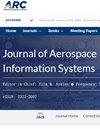Simultaneous Motion Replanning and Gravity Model Refinement near Small Solar System Bodies
IF 1.5
4区 工程技术
Q2 ENGINEERING, AEROSPACE
引用次数: 0
Abstract
Strategic missions to orbit celestial bodies have primarily considered spacecraft trajectories as a two-step process: capture of the spacecraft within the gravitational influence of the body, followed by in-orbit maneuvers. Moreover, a priori maneuver planning approaches using Earth-based measurements tend to generate motion plans that have little scope of replanning, especially when the spacecraft is in the body’s vicinity. Fine-grained motion plans that respond to mission conditions require a detailed understanding of the gravitational forces around the body, which can provide essential information about the body. Our research focuses on a problem variant where the orbital maneuvers are designed to continually refine the onboard gravitational model of the body while simultaneously using the model to perform increasingly smoother orbital maneuvers. We develop a receding horizon approach. Starting with a (low-fidelity) gravity model created from Earth-based observations, the gravity model is continually updated as the spacecraft experiences varying gravitational forces. The updated model is simultaneously and continually used to replan the craft’s trajectory, ensuring that successive maneuvers respect the most up-to-date gravity model. The motion plan eventually attains a near-stable orbital motion. Such an approach has the potential to expand to autonomous missions to improve the mapping and exploration of smaller bodies.太阳系小天体同步运动重规划和重力模型改进
绕天体轨道运行的战略任务主要将航天器轨迹视为一个两步过程:在天体引力影响下捕获航天器,然后进行在轨机动。此外,使用地面测量的先验机动规划方法倾向于生成很少有重新规划范围的运动计划,特别是当航天器在物体附近时。对任务条件做出反应的细粒度运动计划需要对物体周围的引力有详细的了解,这可以提供关于物体的基本信息。我们的研究重点是一个问题变体,其中轨道机动的设计是为了不断完善机载重力模型,同时使用该模型来执行越来越平滑的轨道机动。我们发展后退视界方法。从基于地球的观测创建的(低保真)重力模型开始,重力模型随着航天器经历不同的引力而不断更新。更新后的模型被同时不断地用于重新规划飞船的轨道,确保连续的机动符合最新的重力模型。运动计划最终达到接近稳定的轨道运动。这种方法有可能扩展到自主任务,以改善对较小天体的测绘和探索。
本文章由计算机程序翻译,如有差异,请以英文原文为准。
求助全文
约1分钟内获得全文
求助全文
来源期刊

Journal of Aerospace Information Systems
ENGINEERING, AEROSPACE-
CiteScore
3.70
自引率
13.30%
发文量
58
审稿时长
>12 weeks
期刊介绍:
This Journal is devoted to the dissemination of original archival research papers describing new theoretical developments, novel applications, and case studies regarding advances in aerospace computing, information, and networks and communication systems that address aerospace-specific issues. Issues related to signal processing, electromagnetics, antenna theory, and the basic networking hardware transmission technologies of a network are not within the scope of this journal. Topics include aerospace systems and software engineering; verification and validation of embedded systems; the field known as ‘big data,’ data analytics, machine learning, and knowledge management for aerospace systems; human-automation interaction and systems health management for aerospace systems. Applications of autonomous systems, systems engineering principles, and safety and mission assurance are of particular interest. The Journal also features Technical Notes that discuss particular technical innovations or applications in the topics described above. Papers are also sought that rigorously review the results of recent research developments. In addition to original research papers and reviews, the journal publishes articles that review books, conferences, social media, and new educational modes applicable to the scope of the Journal.
 求助内容:
求助内容: 应助结果提醒方式:
应助结果提醒方式:


